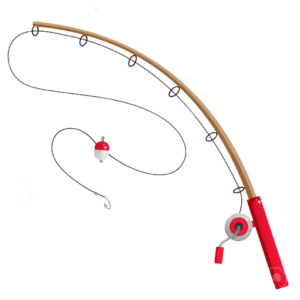
Fishing is one of the best outdoor activities in today’s hectic age. It is a comforting activity that some enjoy as a hobby, and some even make a career out of. Anyone and everyone can enjoy fishing.
If you are a complete beginner in the fishing world, you need to familiarize yourself with the basic techniques and necessities.
The fishing industry has a wide range of participants, and every participant is not a professional
If you want to become a professional fisherman, you need to learn how to assemble and set up your professional fishing tools.
Let’s start with learning how to set up a fishing pole with a bobber. For a professional setup, you require parts that you can purchase separately and assemble yourself. They are given below:
- Bobber
- Fishing line
- Baitcasting reel
- Fishing rod
One of the essential requirements for any professional fisherman is the bobber attached to the fishing line and hook.
A bobber is connected to the same fishing line as the hooked bait and is usually separated by a few inches depending on the fisherman’s preference. Both the bobber and hook are used together to make fishing easier.
What is a Bobber?
A bobber is a small object with sizes ranging from a marble to a tennis ball. It is made of plastic or any other material that floats on the water even when a fish is hooked onto the line.
The primary function is to help the user see where their casted fishing line has landed or is resting.
A fishing line is skinny. Even multi-stranded fishing lines are almost as thin as a strand of hair and therefore make it very hard to pinpoint precisely where the hooked bait landed as soon as it was cast.
A bobber is attached to the same fishing line as the baited hook to be visible to the fisherman since it floats on water.
Why Do We Need a Bobber?
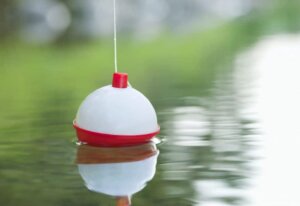
A bobber is essentially a piece of plastic or some other material with similar properties.
The main question that comes to every beginner’s mind is, “why do we need to know where our baited hook is resting?”
There is a good reason for using a bobber in all fishing instances regardless of location or any other constraint.
Once you confirm that a fish has been hooked onto the fishing line and is snagged on the hook, then you should start pulling the line out of the water using your baitcasting reel.
However, when you are pulling your line, there will always be obstacles between you and your catch.
If you do not use a bobber, then you might end up tangling your line in some tree branches or other objects nearby.
A bobber will help you see where your line is, and you can adjust your pull and direction according to the location of the line, which you have determined using the bobber.
This real-time location information is why bobbers are extremely useful when fishing in freshwater areas where there will always be tree branches or small rocks between you and your catch.
Types of Bobbers
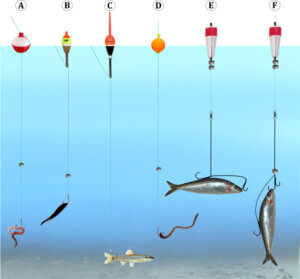
Considering how important bobbers are to the professional fishing industry, their basic categories are quite limited. There are mainly two types of bobbers, which are:
- Fixed bobber
- Slip bobber
Fixed bobber
Fixed bobbers are the most commonly used type of bobber. They are round and are either made of plastic or other materials that can float on water.
They are painted with a bright color that makes it easier to spot them on the surface of the water when the fishing line is cast.
A fixed bobber is used in correspondence to the baited hook. It is attached to the same fishing line as the baited hook.
The distance separating the hook and the bobber is relatively small and can be adjusted by the user accordingly when attaching the bobber to the line.
Disadvantage
A disadvantage of a fixed bobber is that it can only be set to a single place in the line. It cannot move freely along the line.
Due to this disadvantage, a bobber might get pulled into the water if a fish snags onto the hook and starts to swim away.
If the fish can apply enough force, the bobber buoyancy might not hold up since it is extremely lightweight. Therefore, the fixed bobber would get dragged into the water.
In this case, the user might lose sight of where their line is in the water if weather conditions result in low visibility or fishing at night.
Common misperception
When using a bobber, many beginners make one common mistake by using a large bobber for something as measly as catching a trout.
This is a common misperception among beginners since they think bigger is better.
There is a good reason for using an appropriately-sized bobber. If the bobber is too large, it will resist the tug from a fish such as a trout.
If a fish feels any resistance to the bait when it tries to snatch it, then it will leave the area, and you will lose an excellent opportunity to catch your first fish.
A suggestion for choosing the correct bobber would be to target the type of fish you want to catch. Try to use a bobber that you can still see floating on the surface of the water.
It should be sensitive enough to small forces so that it alerts you if a fish has been hooked onto the fishing line, and you can start reeling it in.
Slip bobber
An improvement over the fixed bobber design, a slip bobber has all the benefits of a fixed bobber and added features.
One of the slip design’s primary bonus features is moving along the fishing line with ease.
This feature allows the slip bobber to counteract the force applied on the line through the hook and move along the line.
This way, the fish trying to get to the baited hook does not feel any resistance to its pull, and it can get snagged onto the hook.
Working of a slip bobber
A slip bobber has a hollow center through which a fishing line can be passed. This allows the fishermen to attach only a hook to the fishing line permanently using knots, and the bobber stays on as part of the fishing line.
It can easily move up and down the line depending on the force being exerted on the line.
This type of bobber gives the user all information regarding the fishing line’s location and the baited hook.
As such, the user can keep an eye out to see if the line pulls the bobber down. If the bobber starts to feel some force, it will not go completely into the water; rather, it will oscillate along the fishing line and not apply force to the hook.
This way, the fish is not frightened, and the user can easily view where exactly the line is resting.
You can see your bobber, and you can avoid any obstacles around your line so that your line is not tangled onto foreign objects in your range.
This small design change makes a huge difference in operating capabilities.
The slip design has increased in popularity so much that it has surpassed the fixed bobber industry standard for professional fishers.
Absolute beginners still use fixed bobbers as an easy way to start.
Bobber stop
A bobber stop is used to ensure that the bobber does not stray far away from the surface of the water.
No one wants the bobber to be dangling in mid-air on the fishing line between the hook and the reel.
A bobber stop allows users to make sure that their slip bobber can move along the line does not lose its purpose.
If there are enough waves along the water’s surface, then the bobber might get pushed up the line if a topper is not used.
Different Bobber Designs
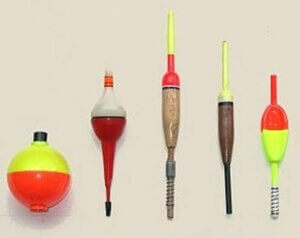
A bobber comes in many different shapes and sizes. As discussed before, the size is dependent on the type of fish you intend to catch.
If you attach a large bobber to catch a small trout, then you might end up scaring the trout away. That is because the large bobber will provide significant resistance to any force applied by the fish.
Choose your preferred bobber type wisely. Ensure that you have attached to the fishing line according to the type of bait and hook size through the baitcasting reel.
Now that you have chosen your bobber type, shape, and size, you can move on to choosing the other parts of a fishing pole. You can then assemble all of them yourself.
Baitcasting reel
A baitcasting reel is the most important part of any fishing pole. It is the primary driving operator in the system and is used to pull out your catch from the water using knobs and gears.
There are many types of baitcasting reels that are available for purchase at different price points.
If you are an absolute beginner, then you do not need the most expensive baitcasting reel.
All you need is a baitcaster that can withstand the force of at least a 20-pound fish. It should help you reel the fish in without having to pull on the line with your own hands.
The perfect baitcaster to use with bobbers would have a lightweight carbon body along with enough gears and bearings to put tension on the fishing line.
This would ensure that the bobber itself does not apply any external pressure to the hook. In turn, the fish will not be scared away.
Any mid-range reel will suffice if you start, and you can upgrade as you learn and practice more.
Fishing Line
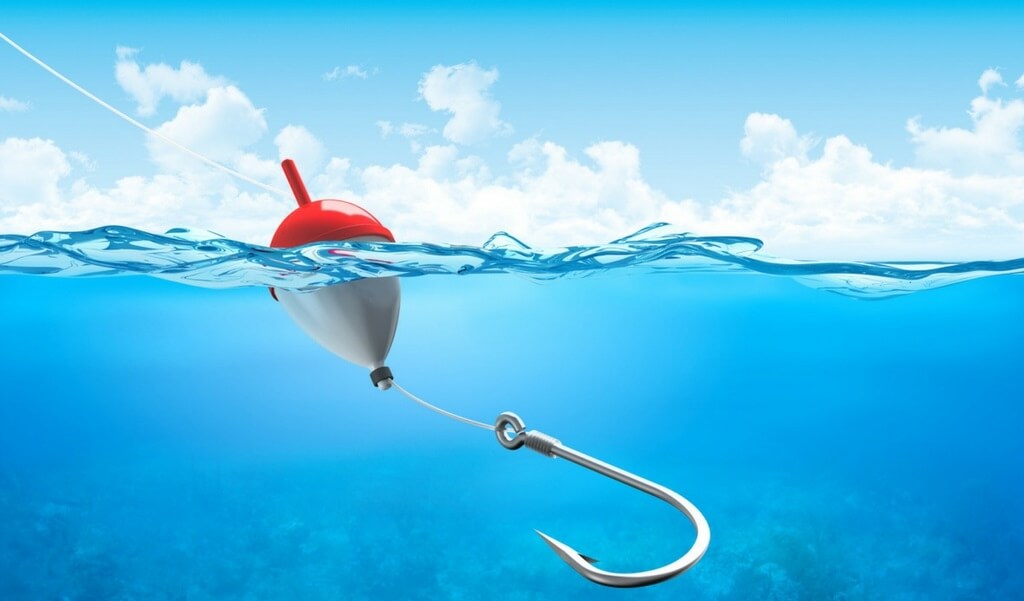
The bobber is attached to or along the fishing line, depending on which type you use. In either case, you need a strong fishing line that will not break under immense pressure.
When a fish is hooked onto the fishing line, it applies force on the line.
At the same time, your bobber tries to stay afloat and also applies some force on the line. You need a multi-stranded fishing line to avoid the line from snapping under such force from two sources.
There are mainly two types of fishing lines that are implemented using multi-stranded filaments. They are:
- Thermally-bonded filaments
These types of fishing lines consist of multiple strands that are thermally bonded together using chemical reactions.
This results in a strong single filament that consists of multiple bonded strands to ensure high-tension capabilities.
- Braided filaments
The braided-filament design is the best multi-stranded fishing line that can be used alongside bobbers.
As discussed, bobbers are lightweight and small, but they can still apply force on the line when a fish is hooked onto it. Therefore, a strong fishing line is necessary.
A fixed bobber is most likely to apply the most force onto the fishing line, and therefore, in this case, a braided bobber is preferred.
If a slip bobber is being used, you need a single-filament design that contains multiple strands. Hence, you will need the thermally-bonded filament.
Fishing Rod
You use your fishing rod to cast out the fishing line once it is set. Its features directly affect your effectiveness as a fisherman. A good quality rod can help you accomplish wonders.
You use your fishing rod to guide your reel when you start pulling in the fish once hooked onto the fishing line.
Your fishing rod should be able to withstand intense situations where it might bend. Therefore, a strong metal rod preferably made of stainless steel is highly recommended.
This recommendation is not just for beginners but also for professionals since such a rod provides the best results.
How to Set Up a Fishing Pole?
Once you have gathered all the necessary parts you need for your fishing pole, you can start assembly. It is relatively easy to assemble, and all you need to do is go through the manuals.
Once your pole is set, you need to reel in your fishing line. A couple of dozen meters seems enough for the line’s total length to go onto the reel.

How to Set Up the Bobber onto the Fishing Line?
Now you can follow the given step-by-step process of setting up your bobber onto the fishing line.
- Pull out 7-8 feet of fishing line out of the reel. Guide it through the guiding holes on the rod. Let the excess line dangle in mid-air.
- First, you will attach the bobber to the fishing line. Please do not attach the hook first since it might get tangled up, and your bobber might sink into the water. Similarly, your hook might not go into the water. Either way, you will not be able to catch fish this way.
- If you use a fixed bobber, then all you need to do is tie a knot onto the bobber. Make sure there is an extra fishing line available for the hook after tying the bobber.
- Now attach the hook using a similar knot and put the bait on it.
- If you use a slip bobber, you need first to attach a bobber stop to the fishing line. This sets the limit to which your bobber can move up the line.
- Now pass the fishing line through the hollow center of the bobber.
- Attach the hook along with the bait.
- Once your fishing line is set, you can cast out your bait and determine the location of your hook and bait using the bobber as your marker.
Conclusion
A bobber is undoubtedly an amazing accessory for fishing. While a bobber is not as high-end as an all-metal fishing reel, it is equally important.
A fishing reel can be expensive. If your line gets snagged onto something, you risk damaging the reel while trying to pull the line with all your strength.
In this case, a bobber can save you a lot of trouble by serving as a guide marker when you start pulling the fish out of the water. We hope this guide for how to set up a fishing pole with a bobber helps!
